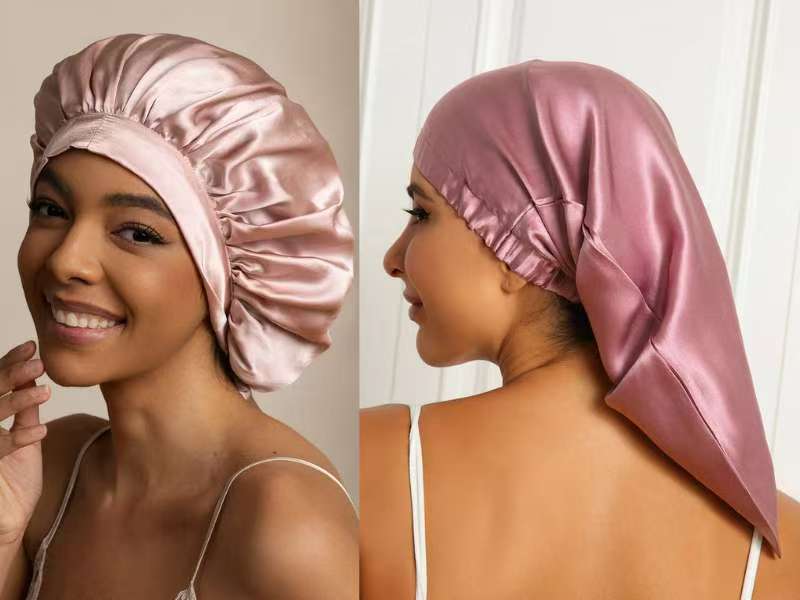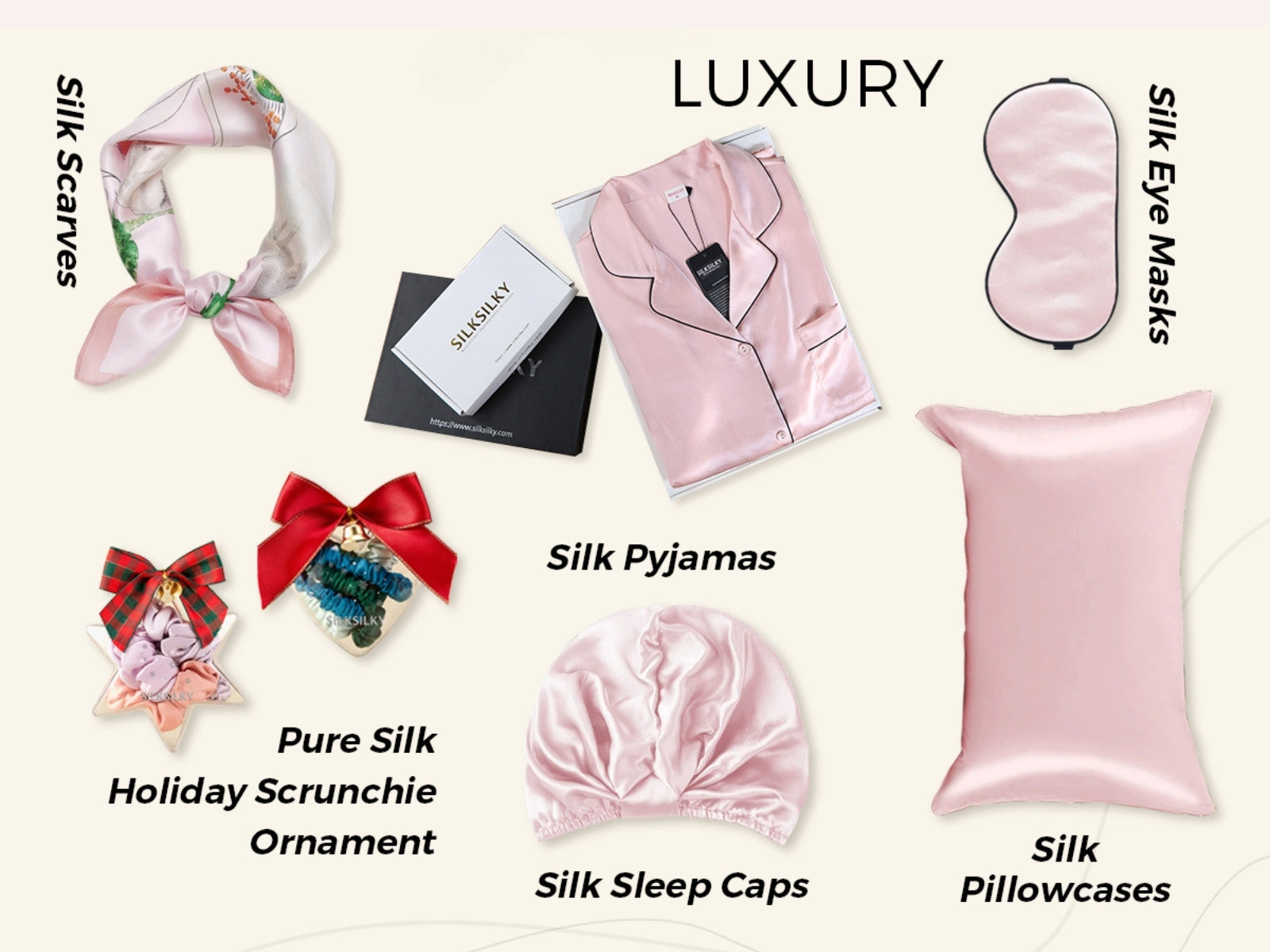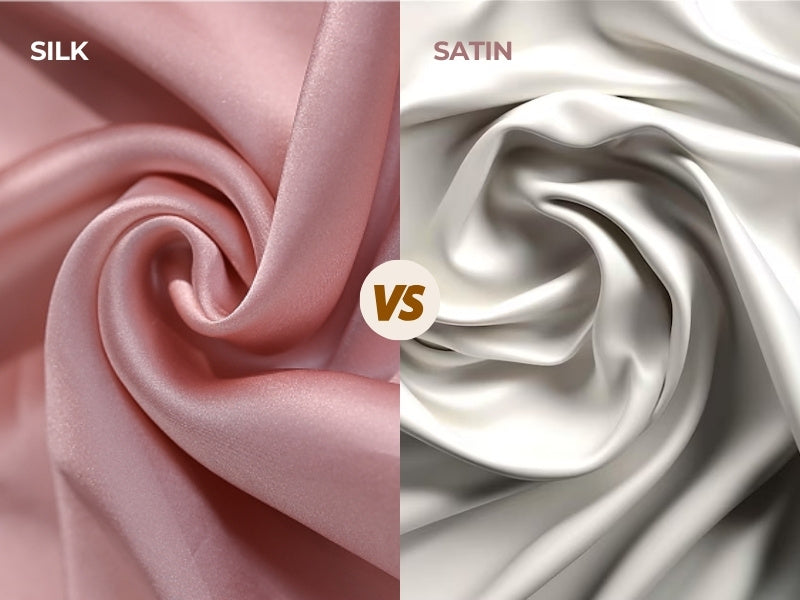What Are the Different Grades of Silk? Complete Silk Quality Guide
Table of Contents
You're browsing silk pillowcases online and notice prices ranging from $20 to $200 - what's the real difference between cheap and expensive silk anyway? The answer comes down to silk grades, a quality classification system that separates basic A-grade silk from luxury 6A silk based on specific standards most people don't know about. Many shoppers waste money on poor-quality silk because they can't tell which grades offer real value for their investment. Learning these silk quality secrets means you'll never overpay for mediocre silk or get fooled by fancy marketing again.
The Complete Silk Grading Scale
Silk Quality Comparison Chart
| Grade | Uniformity | Fiber Quality | Thread Count | Price Range | Lifespan |
| 6A | 95%+ | Ultra-premium | 750+ | $80-400/yard | 20-30 years |
| 5A | 90-95% | Premium | 600-750 | $60-150/yard | 15-20 years |
| 4A | 90-95% | Premium | 500-600 | $50-120/yard | 10-15 years |
| 3A | 85-90% | Mid-range | 400-500 | $35-80/yard | 8-12 years |
| 2A | 85-90% | Mid-range | 300-400 | $25-60/yard | 5-8 years |
| A | 80-85% | Basic | 200-300 | $25-50/yard | 3-5 years |
Grade A Silk: Your Entry Point
Grade A silk offers basic premium quality with 80-85% fiber uniformity and decent durability. You'll find continuous mulberry silk fibers with some minor texture variations and a moderate natural sheen.
- Perfect for: Everyday clothing, entry-level silk bedding, casual accessories, and first-time silk buyers wanting to experience silk benefits without premium pricing.
- Where to find it: Online retailers, department stores, and mainstream silk brands commonly stock Grade A products. Expect to pay $25-50 per yard, making it the most accessible genuine silk option.
Grade 2A-3A Silk: The Sweet Spot
Quality upgrades include smoother texture, improved luster, and 85-90% fiber uniformity. These grades eliminate most imperfections found in Grade A while maintaining reasonable pricing.
- Best value proposition: You get 80% of premium silk benefits at 50% of top-tier pricing. Perfect for quality bedding (19-22 momme weight), professional wear, and items you'll use regularly.
- Smart investment for: Mid-range designer pieces, quality silk pillowcases, and anyone wanting noticeable silk benefits with good longevity.
Grade 4A-5A Silk: Premium Performance
Premium characteristics include exceptional smoothness, brilliant natural luster, and 90-95% fiber uniformity. These grades provide superior hair and skin benefits with impressive durability.
- When to invest: Choose these grades for frequently used items like daily bedding, professional accessories, or when silk quality significantly impacts your experience. The higher upfront cost pays off through extended lifespan and superior performance.
- Investment sweet spot: These grades offer luxury quality at more accessible prices than 6A, making them ideal for discerning buyers who want premium benefits without ultra-luxury costs.
Grade 6A Silk: Ultimate Luxury
Ultimate quality standards represent silk perfection with 95%+ fiber uniformity and maximum durability. This grade features the longest, strongest mulberry silk fibers available.
Technical specifications:
- 750+ thread count creates incredibly smooth, dense fabric
- 100% long-strand mulberry silk fibers ensure maximum strength and luster
- Natural protein retention preserves all 18 essential amino acids
- Seamless weaving techniques eliminate weak points and texture variations
Grade 6A silk offers 20-30 year lifespan with proper care and maintains value over time. While expensive ($80-400 per yard), the combination of rarity, performance, and longevity makes it worthwhile for luxury silk bedding, couture fashion, and heirloom pieces.

How to Identify Quality Silk: Practical Testing Methods
1. Look at the Shine and Weave
- Check the luster and sheen quality first - genuine silk has a distinctive pearl-like shine that changes when you move it under light. High-quality silk shows consistent brightness, while fake silk looks either too shiny (synthetic) or completely matte (low grade).
- Examine weave consistency by looking closely at the fabric. Real silk shows slight natural irregularities that prove it's handmade, while perfect uniformity often indicates machine-made synthetic materials. Quality silk has tight, even weaves without loose threads or gaps.
2. Feel the Fabric
- Test smoothness and texture by running your fingers across the fabric. Authentic silk feels incredibly smooth yet slightly textured, never slippery like polyester. High-grade silk should feel cool to the touch and warm up quickly from your body heat.
- Assess weight and drape - real silk has surprising weight for its thinness and drapes beautifully when held up. Fake silk either feels too light and flimsy or unnaturally heavy and stiff.
3. Try the Burn Test
Carefully burn a small thread from an inconspicuous area. Real silk burns slowly, smells like burning hair, and leaves soft gray ash that crumbles easily. Synthetic materials burn fast, smell chemical-like, and leave hard, dark beads.
4. Watch Out for Cheap Prices
Be suspicious of extremely low prices - genuine silk costs at least $25-30 per yard wholesale. "Silk" bedding under $50 for a set is almost certainly fake. Quality silk requires significant investment in materials and processing, making bargain-basement prices impossible for authentic products.
Silk Types and Their Natural Grades
Not all silk starts equal - the type of silkworm and how it's raised directly affects what grade the final product can achieve. Some silk varieties naturally hit higher quality standards, while others have built-in limitations that cap their maximum grade.
Silk Types and Maximum Grade Potential
| Silk Type | Source | Max Grade | Key Characteristics | Common Uses |
| Mulberry Silk | Cultivated silkworms | 6A | Finest fibers, consistent quality | Premium bedding, luxury fashion |
| Tussah Silk | Wild silkworms | 3A-4A | Natural tan color, coarser texture | Casual clothing, home decor |
| Eri Silk | Eri silkworms | 2A-3A | Soft, wool-like feel | Shawls, warm clothing |
| Muga Silk | Wild Assam silkworms | 4A-5A | Golden color, very durable | Traditional garments |

Why Mulberry Silk Grades Highest
Mulberry silk consistently achieves the highest grades because cultivated silkworms eat only mulberry leaves, producing incredibly fine, uniform fibers. The controlled environment means consistent quality with long, strong threads that create smooth, lustrous fabric.
Wild Silk Quality Limitations
These are governed by inherent restrictions in grades because wild silkworms feed on a variety of plants whose fibre quality varies, leading to unequal fibre quality. Impurities and discontinuities in the threads of silk caused by weather also result in those varieties not reaching 5A-6A grades.
Wild silk versus cultivated silk reveals distinct gradings in quality - cultivated silk provides greater uniformity and tensile strength when compared to wild silk, which offers distinct textures and natural dyes but is unable to compete with premium grades available for mulberry silk.
Which Silk Grade Should You Buy? Practical Buying Guide
For Budget-Conscious Buyers
- Grade 2A-3A provides the best value for everyone - you receive real silk advantages without overspending. These grades are priced between $25-$80 per yard and are extremely durable with 8-12 year durability.
- Grade A is suitable for beginners who are interested in trying out silk with minimal investment. At $25-50 per yard, it is ideal for trying out if you like feeling silk and its benefits before upgrading later.
- Skip grades lower than A - they are frequently low quality with low durability, which end up incurring more costs in replacement.
For Luxury Seekers
Invest in 5A-6A grades when:
- You use the item daily (like pillowcases or sheets)
- Quality significantly impacts your experience
- You want maximum hair and skin benefits
- You prefer buying once and keeping it for decades
4A-5A grades hit the luxury sweet spot - premium performance at reasonable prices compared to ultra-luxury 6A.
Specific Use Case Recommendations
| Use Case | Recommended Grade | Why This Grade |
| Silk Pillowcases | 4A-5A (22-25 momme) | Maximum hair/skin benefits, daily use |
| Silk Sheets | 3A-4A (19-22 momme) | Good durability, comfortable feel |
| Evening Wear | 4A-6A | Premium appearance for special occasions |
| Daily Blouses | 2A-3A | Practical quality for regular wear |
| Scarves | 2A-4A | Depends on frequency of use |
| Ties | 3A-4A | Professional appearance, regular handling |
Match your grade to how often you'll use the item and how much the quality matters to your daily experience. Higher grades always provide better value for frequently used items.
Choose Your Silk Grade Wisely
You've learned what makes 6A silk worth the premium and why Grade A works for beginners. The smart move is matching silk grades to your lifestyle - higher grades make sense for daily-use items like pillowcases, while mid-range works great for occasional pieces. Skip anything priced suspiciously low since real silk quality costs money to produce. Start shopping with confidence knowing exactly which silk grade delivers the best value for your specific needs,also learns how to choose silk gifts.
Frequently Asked Questions About Silk Grades and Quality
Q1: How is silk grade distinct from momme weight?
Silk grade refers to fibre quality and making standards (A to 6A), whereas momme weight refers to weight and density in a piece of fabric. Momme is computed as weight per 100 yards for 45-inch wide fabric. Grade is equivalent to raw fibre quality, and momme is how thick you want the end product fabric to feel.
Q2: Is 6A silk worth paying for?
Yes, if you use it daily or desire ultimate durability. 6A high-quality silk is only available in the world's best 3-5% mulberry silk production and is 20-30 years durable if you use it with care. 3A-4A grades are a better value for applications for less-than-everyday applications.
Q3: How much momme weight should I use for my silk bedding?
Sheets in 19-25 momme are ideal; those less are not appropriate for quality bedding. 19mm for a lightweight feel; 22mm for a balanced durability; 25mm for ultimate luxury and durability.
Q4: How can I identify if it is real or fake silk?
True silk burns slowly, with a hair-burning odour, leaving soft gray ash. Fake materials burn quickly with chemical smells and hard beads for ash. Also, look for natural irregularity - absolute perfection is a giveaway for fake materials.
Q5: Do I need to wash it at home or take it for dry cleaning?
Silk is not washed at home except if it is marked specifically as "Dry Clean Only." Cold water (below 30°C), mild liquid detergent specifically for silk, and no enzymes or bleach are used. Luxury grades are safest for hand washing.
Q6: Why is mulberry silk more expensive compared to other kinds?
Mulberry silk is made from mulberry-feeding silkworms, which yield very uniform, strong fibers with superior luster. Wild silks are coarser fibers that are unable to achieve comparable quality grades.
Q7: How much thread count should I seek in a silk?
Silk versus cotton is not so much about thread count. 400+ thread quilts are superior 19mm silk quilts; 600+ are 22mm; 750+ are 25mm per square inch. Pay attention to momme weight and grade, not thread count only.
Q8: How long does a standard rank of silk last?
Grade A is durable for 3-5 years, 2A-3A for 5-8 years, 4A-5A for 10-15 years, whereas 6A is durable for 20-30 years if it is maintained properly. Higher grades enable longer durability for items that are in use regularly.
Q9: What is the ideal silk level for starters?
Start with 2A-3A quality silk - it provides genuine silk benefits at economical prices ($35-80/yd) and lasts 8-12 years. That gives you access to silk quality without high-investment expenses while you decide if you'd like to make an upgrade later.
![[Light Blue] SilkSilky Pure Silk Notch Collar Women's Pajamas 001,](http://silksilky.com/cdn/shop/files/ab83afb9301666ee2f174a8ae72ffda4_4e9bb488-7880-40fe-9e69-f0fd823857c5.jpg?v=1764653199&width=1200)
![[Light Blue] SilkSilky Pure Silk Notch Collar Women's Pajamas 002,](http://silksilky.com/cdn/shop/files/db8dbeee5354fe3b631b963715847ffe.jpg?v=1764653202&width=1200)
![[Dark Red] SilkSilky Pure Silk Notch Collar Women's Pajamas 001,](http://silksilky.com/cdn/shop/files/599ed0811e1a5fcfa55bdc80a0279704_2643c850-a793-4475-a52b-7fef1bbd7e36.jpg?v=1762233837&width=1200)
![[Dark Red] SilkSilky Pure Silk Notch Collar Women's Pajamas 002,](http://silksilky.com/cdn/shop/files/9e022d4dd4f99aed4af8da3f58fcfd5b_efb9bafe-3d71-4283-9b81-e339ff08f352.jpg?v=1762233837&width=1200)
![[White] SilkSilky Pure Silk V Neck Nightgown 001,](http://silksilky.com/cdn/shop/files/a8ae95260a57844b1e2e00c4fcfabdcc_b922b270-af10-4e96-9493-0d877bd663db.jpg?v=1764140639&width=1200)
![[White] SilkSilky Pure Silk V Neck Nightgown 002,](http://silksilky.com/cdn/shop/files/24ac506750f8c38c51bb5b6d0ee15287.jpg?v=1764140639&width=1200)
![[Pink] SilkSilky Pure Silk Sleep Cap 001,](http://silksilky.com/cdn/shop/files/SilkSilky_Pure_Silk_Sleep_Cap_Pink_001_C-250529006.jpg?v=1762221980&width=1200)
![[Pink] SilkSilky Pure Silk Sleep Cap 002,](http://silksilky.com/cdn/shop/files/SilkSilky_Pure_Silk_Sleep_Cap_Pink_002_C-250529006.jpg?v=1762221980&width=1200)
![[Champagne] SilkSilky Pure Silk Round Neck Women's Pajamas 001,](http://silksilky.com/cdn/shop/files/4cd008b260b48a735910ef47a0ffcede_154de09c-492d-4405-a783-c5caa649ff51.jpg?v=1762322738&width=1200)
![[Champagne] SilkSilky Pure Silk Round Neck Women's Pajamas 002,](http://silksilky.com/cdn/shop/files/322ae8e3d97b01938181e0aae5a68459.jpg?v=1762322738&width=1200)






